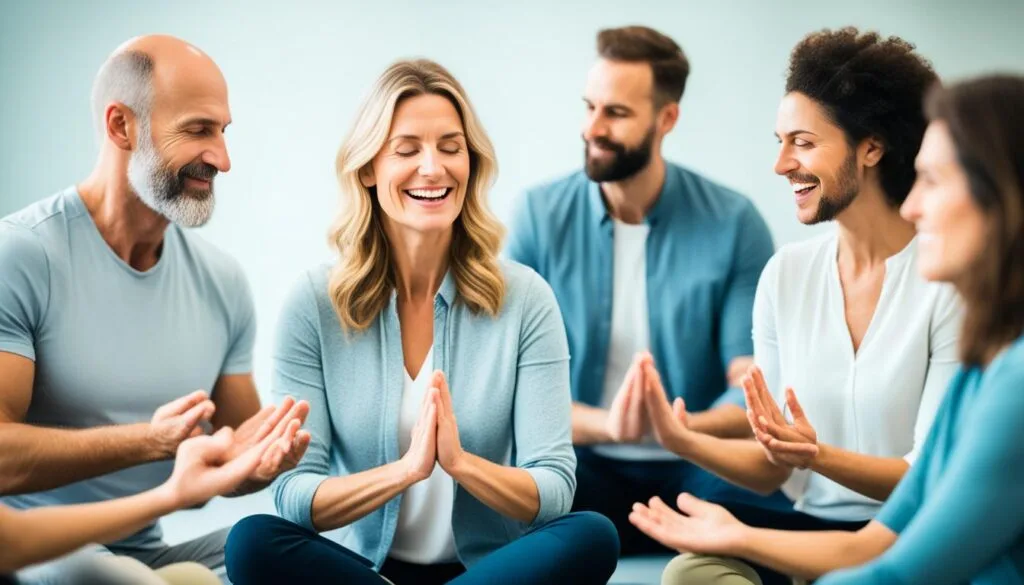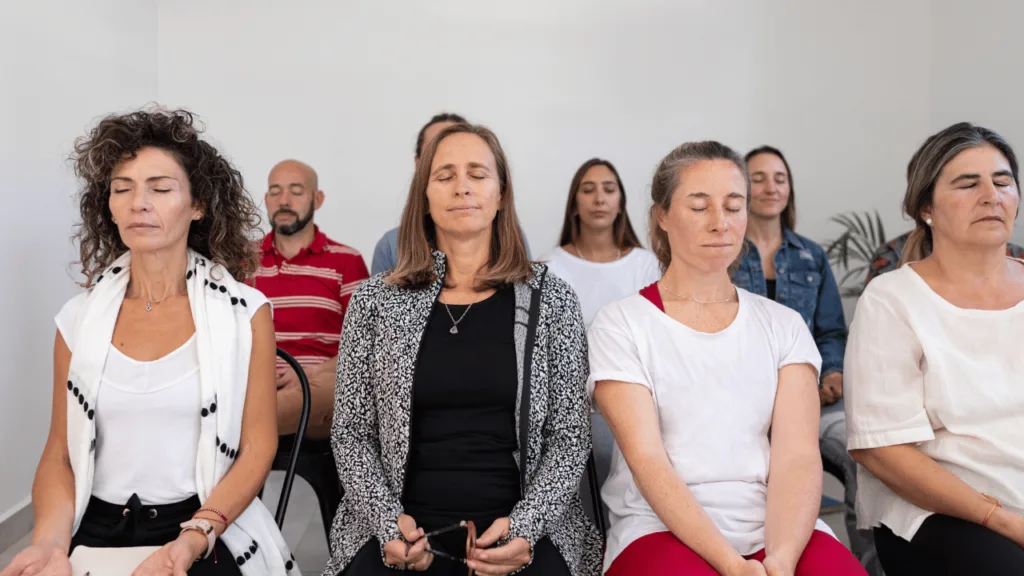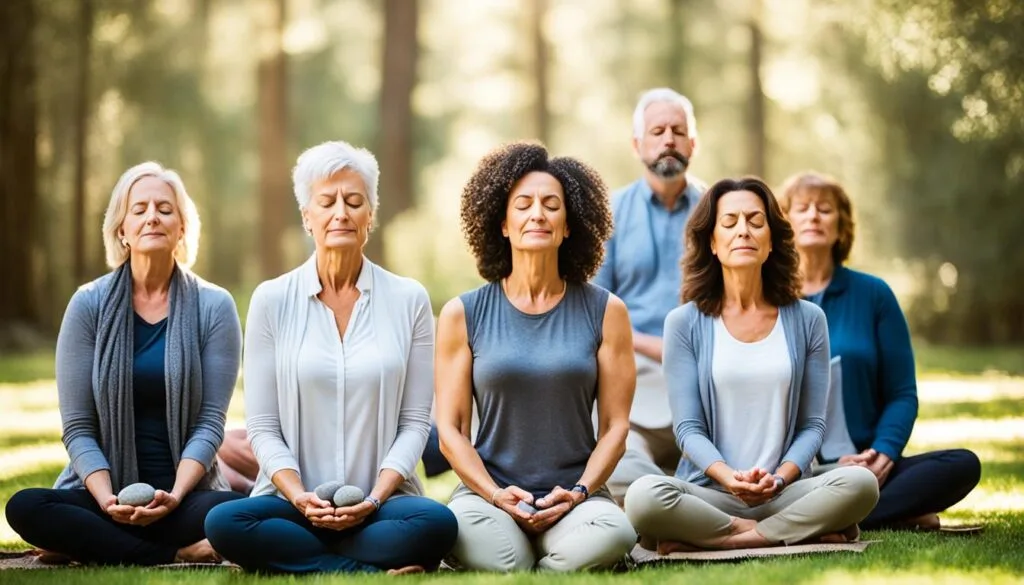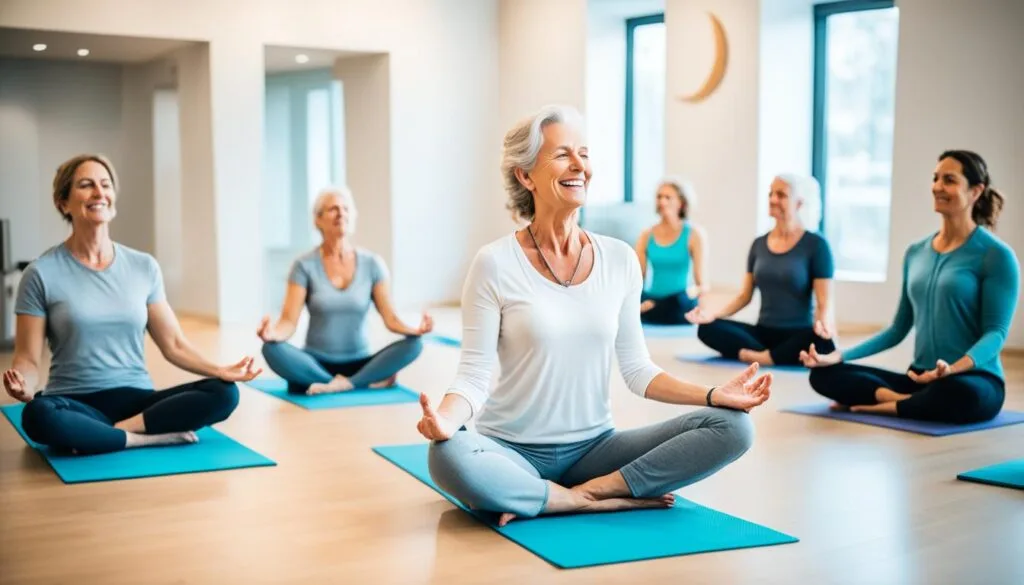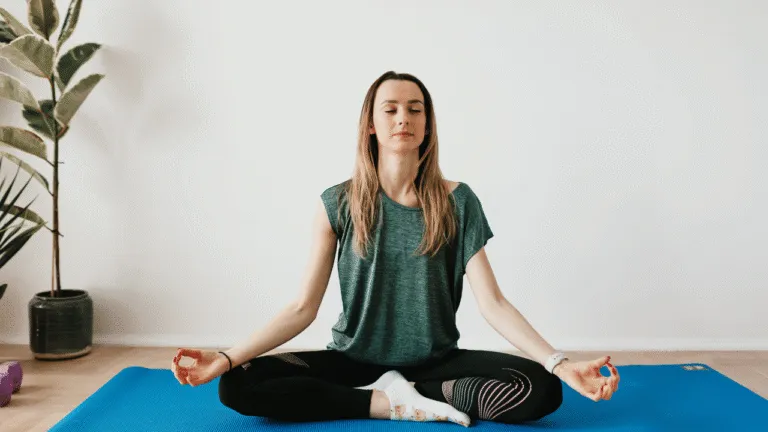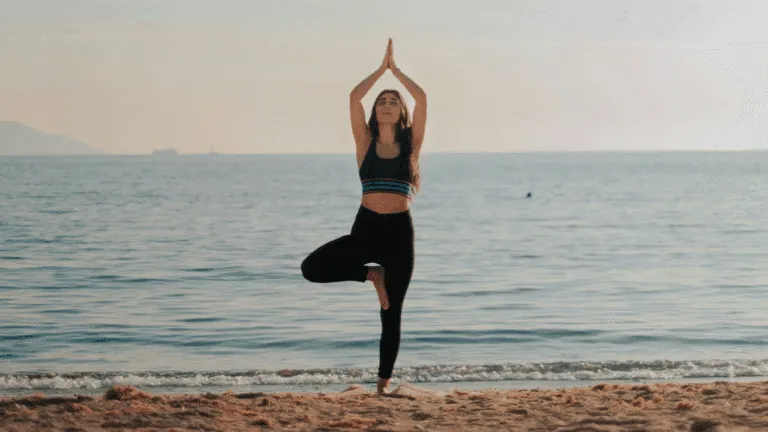Empowering DBT Mindfulness Activities for Groups Therapy

DBT Mindfulness Activities for Groups In the world of Dialectical Behavior Therapy (DBT), group mindfulness practices are key to healing and growth. These exercises help people find themselves, manage their feelings, and work better with others. By doing DBT activities together, people change deeply and build a strong community.
DBT groups mix different experiences, like mindfulness, handling stress, getting along with others, and managing feelings. In these groups, people learn to see the now without judgment. They learn how to breathe mindfully, do body scans, and eat with awareness. This helps them deal with life’s ups and downs more smoothly.
In these groups, people find comfort in knowing they’re not alone. They share their struggles and learn from each other. Doing DBT activities together, they grow more aware of themselves, kinder to others, and stronger to face life.
Key Takeaways
- DBT group mindfulness practices foster a supportive environment for collective healing and growth.
- Mindful group exercises encompass the core modules of mindfulness, distress tolerance, interpersonal effectiveness, and emotional regulation.
- Participants learn valuable skills such as mindful breathing, body scan meditation, and mindful eating.
- Group sessions normalize struggles and cultivate empathy, self-awareness, and resilience.
- Engaging in DBT mindfulness activities empowers individuals to navigate life’s challenges with greater ease and clarity.
The Power of Group Dynamics in DBT Mindfulness Practice
Dialectical Behavior Therapy (DBT) has shown how group mindfulness can change lives. By joining forces, people find support, motivation, and strength. Over the years, more people have found group mindfulness training, helping them grow and heal.
When people practice mindfulness together, they feel connected. They push each other to live in the moment. This connection makes them more committed and helps them do better, as studies show.
Creating a Supportive Environment for Collective Growth
Groups doing mindfulness, like Mindfulness-Based Cognitive Therapy (MBCT), help improve mental health. They learn to handle thoughts, feelings, and body signals together. A 2020 study showed that group mindfulness helped people with asthma feel less anxious and stressed.
Group activities like setting goals and breathing together work well. They fit everyone’s unique stories and struggles, creating unity. Doing yoga breathing together strengthens mindfulness and builds strong relationships and confidence.
Normalizing Challenges and Fostering Resilience
Group mindfulness makes it clear that everyone faces challenges. Seeing others’ struggles helps us feel less alone. This understanding brings validation and support, giving us hope and motivation to grow.
In the group setting, we discover that our struggles are not unique. We find solace in the knowledge that others have faced similar challenges and have found the strength to overcome them. This realization ignites a spark of resilience within us, empowering us to face our own obstacles with renewed courage and determination.
Group dynamics make DBT mindfulness a powerful tool for healing and growth. By supporting each other, people build resilience that lasts beyond the group. They take this strength and wisdom into their everyday lives, facing challenges with more ease and grace.
Mindfulness Exercises for DBT Group Sessions
In Dialectical Behavior Therapy (DBT) group sessions, mindfulness exercises are key. They help people stay in the moment, manage their feelings, and handle stress better. By using practices like mindful breathing, body scan meditation, and mindful eating, DBT groups create a place for healing and growth. Studies show these exercises can lessen depression, anxiety, and PTSD symptoms. They also improve sleep, relationships, and how well people cope with tough situations.
Mindful Breathing Techniques
Mindful breathing is a key practice in DBT groups. It helps people stay present and feel calm. Some ways to breathe mindfully include:
- Breathing colors: Imagine inhaling a calming color and exhaling a stressful one
- Square breathing: Breathe in for four counts, hold for four, breathe out for four, and hold again for four
- Deep breathing: Take slow, deep breaths from the belly
- Belly breathing: Put one hand on the chest and the other on the belly. Focus on the belly’s rise and fall with each breath
Doing these breathing exercises often helps people in mindfulness groups become more aware of themselves and their feelings.
Body Scan Meditation
Body scan meditation is a strong tool in DBT groups. It means paying attention to different body parts, noticing feelings or tension without judging them. This helps people connect with their bodies and release stress.
A body scan meditation guide asks participants to focus on each body part, from toes to head, noticing and accepting feelings without judgment.
Regular body scan meditation can lessen chronic pain and boost overall well-being, research shows.
Mindful Eating Experiences
Mindful eating, like the grape exercise, is a special way to practice mindfulness in groups. Participants are given a grape and told to explore it with all senses before eating it slowly and mindfully. This helps people enjoy life’s simple pleasures and eat more mindfully.
| Sense | Mindful Eating Prompts |
|---|---|
| Sight | Look at the food’s color, shape, and texture |
| Touch | Feel the food’s surface, temperature, and weight |
| Smell | Notice any smells coming from the food |
| Sound | Listen for sounds the food makes when touched or bitten |
| Taste | Enjoy the flavors, textures, and sensations while chewing and swallowing |
Mindful eating can prevent binge eating and improve how people see themselves and food. By adding mindful breathing, body scan meditation, and mindful eating to DBT groups, facilitators help people learn important skills. These skills are for managing feelings, handling stress, and improving overall well-being.
Cultivating Present-Moment Awareness in Group Settings
Group dynamics bring a deep sense of awareness to the present moment. Group mindfulness practices start a journey of growth and self-discovery for everyone. In these sessions, people share their experiences and insights. They learn from exercises like mindful observation and self-compassion meditation.
Studies show that mindfulness helps improve well-being. A study by Goldberg SB et al. shows how mindfulness helps with mental health issues. By focusing on now, group therapy members become more aware of themselves and their feelings.
Being in a mindful group helps people bring mindfulness into their everyday life. Simple acts like eating or listening mindfully change how we see our thoughts and feelings. By noticing the world around them, people learn to appreciate the now more.
Mindfulness is not about living life in slow motion. It’s about enhancing the quality of your life by being fully present in each moment, whether you’re going slow or fast.
Mindfulness does more than help individuals. It also helps the brain, making it better at attention and handling emotions. This makes people in group therapy more resilient and clear-headed in tough times.
| Mindfulness Exercise | Benefits |
|---|---|
| Mindful Breathing | Reduces stress and anxiety, promotes relaxation |
| Body Scan Meditation | Enhances body awareness, reduces tension |
| Mindful Eating | Promotes healthy eating habits, increases enjoyment of food |
| Mindful Walking | Boosts physical activity, improves focus and concentration |
Being in a group helps people discover themselves and heal together. Through mindful exercises, they gain tools to face life’s challenges better. Embrace the now, and discover the great potential within.
Creative Mindfulness Activities for DBT Groups
Doing creative mindfulness activities in DBT groups can make the therapy better for everyone. It helps clients connect with now in new ways. These activities make the group feel closer and help everyone see things from their own view.
Mindful Art Exploration
Mindful art is great for being in the moment and expressing yourself. Therapists ask clients to look closely at an object or scene. They notice colors, textures, and shapes without judging.
This helps people feel safe to explore their feelings and senses. It can lead to deep insights and a better understanding of themselves and others.
Music and Sound-Based Mindfulness Practices
Music and sound can change how clients feel in the moment. By listening deeply, they can notice the details of music. This helps them relax and become more aware of the beauty of sound.
Therapists can use different music and instruments to make sessions fun and varied for everyone.
| Mindfulness Activity | Effectiveness Rating |
|---|---|
| Mindful Breathing | 4.5/5 |
| Body Scan Meditation | 4.2/5 |
| Mindful Eating | 4.0/5 |
| Guided Imagery | 4.3/5 |
| Progressive Muscle Relaxation | 4.1/5 |
Mindful Movement and Yoga
Mindful movement and yoga let clients connect with their bodies and breath. They focus on how they feel during each move. This helps them be more present and aware of themselves.
These activities are good for the body and help with feelings. Therapists can change the movements to fit the group’s needs.
“Mindfulness is the aware, balanced acceptance of the present experience. It isn’t more complicated than that. It is opening to or receiving the present moment, pleasant or unpleasant, just as it is, without either clinging to it or rejecting it.” – Sylvia Boorstein
Adding creative mindfulness to DBT groups helps clients live in the moment. It helps them know themselves better and feel connected with others. These new ways of practicing mindfulness make therapy better and give clients tools for everyday life.
Integrating DBT Mindfulness Activities for Groups into Daily Life
The true power of mindfulness group facilitation comes from using skills learned in daily life. By practicing DBT mindfulness activities for groups regularly, people can grow in self-awareness and emotional control. This leads to better well-being overall.
One way to add mindfulness to daily life is through simple practices like mindful breathing and eating. These practices, learned in group training, fit easily into busy days. For example, focusing on breath before a tough task or eating with full attention can change one’s mindset and well-being.
“Mindfulness is a way of befriending ourselves and our experience.” – Jon Kabat-Zinn
Another key part of daily mindfulness is being non-judgmental. Accepting and being kind to one’s thoughts and feelings helps stop self-criticism. This leads to more resilience and easier handling of life’s challenges.
| Daily Mindfulness Practice | Benefits |
|---|---|
| Mindful Breathing | Reduces stress, improves focus, and promotes relaxation |
| Body Scan Meditation | Increases body awareness, releases tension, and enhances self-compassion |
| Mindful Eating | Promotes healthy eating habits, improves digestion, and enhances enjoyment of meals |
| Mindful Movement | Boosts physical and mental well-being, reduces anxiety, and improves flexibility |
Being consistent with mindfulness practice is important. Regular time set aside for mindfulness helps in staying present and dealing with stress. As people keep doing DBT mindfulness activities for groups, they start a journey towards lasting personal growth and well-being.
Overcoming Obstacles in Group Mindfulness Practice
Group mindfulness exercises can change lives, building connections and support. Yet, people often face challenges. By tackling these issues, leaders can make the experience welcoming for everyone.
Addressing Common Challenges and Concerns
One big challenge is that everyone has different experiences and comfort levels. Some might find it hard to stay focused, while others might feel judged or not good enough. Jon Kabat-Zinn, a top mindfulness teacher, says, “Mindfulness isn’t hard… We just need to remember to do it.” Leaders can ease these worries by making the effort normal and offering help.
Leaders can use the advice of mindfulness experts to motivate and support people. Thich Nhãt Hanh, a famous Zen master, talks about the need for patience and kindness in mindfulness:
“Drink your tea slowly and reverently, as if it is the axis on which the world earth revolves – slowly, evenly, without rushing toward the future.”
Creating a caring and understanding space helps people overcome their challenges in group mindfulness practices.
Adapting Mindfulness Exercises for Diverse Needs
It’s key to make mindfulness exercises work for everyone. This means changing them for people with physical issues, respecting different cultures, or offering options that feel right to each person.
Using affirmation cards and mindfulness quotes can really help people stay positive and focused on mindfulness. Leaders can use books like “The Little Book of Wisdom: Change Your Outlook One Day at a Time” and “Mindfulness Quotes: Thoughts for Meditation, Inner Peace and Change” to give daily motivation and advice.
The DBT program at Rockland Recovery Behavioral Health in Sharon, MA, shows how well tailored group therapy can work. By using a mix of mindful group exercises, like deep breathing, body scan meditation, and guided imagery, leaders help people stay in the moment, no matter their situation.
Changing mindfulness exercises might mean:
- Offering seated or lying down options for movement-based practices
- Providing visual or auditory aids for guided meditations
- Using culturally relevant examples or metaphors
- Letting people pick what they focus on during exercises
Being flexible and creative in changing exercises helps leaders make sure everyone feels supported and strong in their journey to better self-awareness and emotional health.
The Role of Facilitators in Guiding Group Mindfulness Activities
Facilitators are key to making mindfulness group therapy successful. They create a place where everyone can grow and heal together. They set the mood and lead by example, helping people bring mindfulness into their everyday life.
Setting the Tone and Creating a Safe Space
Facilitators make sure the group feels safe and free from judgment. They build trust by listening well and showing empathy. This lets everyone feel okay sharing their stories and feelings.
They start sessions with exercises to help everyone focus on the now. They also set rules like keeping things confidential and being respectful. This makes the group a safe place for everyone.
Encouraging Participation and Sharing
Facilitators help everyone get involved in the group therapy. They make sure people share their thoughts and feelings about mindfulness. By being open themselves, they encourage others to do the same.
To get people talking, facilitators use different methods like:
- Asking open questions to get people thinking and talking
- Doing activities in pairs or small groups for support
- Using creative things like art or writing to let people express themselves
- Thanking everyone for what they share
| Facilitation Technique | Purpose |
|---|---|
| Active Listening | Show empathy and understanding |
| Open-ended Questions | Start discussions and reflection |
| Pair or Small Group Activities | Help people support and share with each other |
| Creative Exercises | Help people express themselves and gain insight |
Facilitators make the group a place where everyone feels they belong. This helps everyone do better in their mindfulness journey. They make the group therapy more effective.
“The role of the facilitator is to create a safe and supportive space where participants can explore their inner world with curiosity and compassion. It’s about guiding them to discover their own wisdom and strength through mindfulness practices.”
As the group goes on, facilitators change how they lead to fit the group’s needs. They keep guiding, supporting, and encouraging everyone. This helps people deepen their mindfulness and use it in their daily life. Facilitators are key to helping the group heal and change for the better.
dbt mindfulness activities for groups: Empowering Collective Healing
DBT mindfulness activities in groups help people heal and grow together. In these workshops, people from different backgrounds learn and practice skills for better emotional health. Led by experts in group facilitation, these sessions offer a safe space for sharing and support.
These training sessions let people know they’re not alone in their struggles. Through activities like guided meditations and mindful movement, they learn to be more aware and kind to themselves. The group setting also means they get feedback and support from others, building a strong sense of community.
As people go through these activities, they learn how to handle stress and tough feelings better. This helps them feel better overall. They start to use mindfulness in their everyday life, thanks to the group’s support. This leads to more resilience and the ability to handle life’s ups and downs more smoothly.
DBT mindfulness groups are a powerful way to change lives and heal together. They offer a chance to share experiences and grow emotionally. By learning mindfulness skills, people find peace, understanding, and the tools for a happier life.

